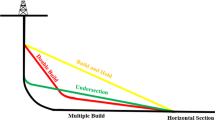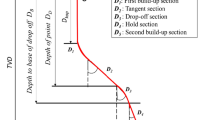In horizontal well drilling, the success of the drilling operation mainly depends on optimal selection of the drilling trajectory. In this paper-, we propose a method for optimizing horizontal well trajectory design based on the numerical optimization methods PSO (particle swarm optimization) and AHP (analytic hierarchy process). We selected four functions as the parameters which affect the selection of the optimal solution: the shortest length of the well trajectory, the highest target hitting accuracy, the lowest cost of drilling, and the least drilling string friction. The key parameters for a horizontal well (the KOP (kick-off point), BUR (buildup rate), and hold angle) were calculated by ththe PSO method in Matlab. Applying the AHP mathematical tool for a systematic approach to decision-making, we ranked the solutions according to the engineering and design requirements. The new method proposed in this paper lets us overcome the limitations of the optimization algorithm and to recast empirical judgments of experienced analyzers in mathematical language, thus avoiding subjectivity in selecting the best solution. The method was applied to and tested on conditions of the Yanchang field. As shown by the experimental study, the proposed method is a simple and reliable method for selecting the optimal trajectory.


Similar content being viewed by others
References
Mancang Sui, Da Zhang, and Chengwei Lan, “Optimizing for horizontal well hole trajectory,” Journal of Jianghan Petroleum Institute, 22, 25-26 (2000)
Yan Zhang, Ji Li, Kunfang Liu et al., “Directional wellbore trajectory optimization design method,” Gas Industry, 20, 57-60 (2000).
B. Yeten, L. J. Durlofsky, and K. Aziz, “Optimization of non-conventional well type, location and trajectory,” SPE Annual Technical Conference and Exhibition, San Antonio, Texas (2002).
Huixin Liu and Yingfeng Meng, “Directional wells optimal well trajectory study,” Gas Industry, 24, 64-67 (2004).
Tie Yan, Weikai Liu, Ye Zhou et al., “Optimal design of trajectory for stepped horizontal wells,” Petroleum Engineering, 29, 8-10 (2007).
Deli Gao et al., Well Trajectory Control, Petroleum University Publishing Press, Dongying, ShanDong (1994).
T. Saaty, Analytic Hierarchy Process, McGraw-Hill, New York (1980).
This study was carried out with the financial support of the National Natural Sciences Foundation of China (Grants 51774304, 51734010, L11762211, 51574262, 51774063), the National Oil and Gas Major Projects Fund of China (Grant 201=05009), the Innovative Research Groups Fund of the National Natural Sciences Foundation of China (Grant 51821092), and the State Key Laboratory of Petroleum Resources and Engineering of China.
Author information
Authors and Affiliations
Corresponding author
Additional information
Translated from Khimiya i Tekhnologiya Topliv i Masel, No. 1, pp. 65 — 70, January — February, 2019.
Rights and permissions
About this article
Cite this article
Li, J., Mang, H., Sun, T. et al. Method for Designing the Optimal Trajectory for Drilling a Horizontal Well, Based on Particle Swarm Optimization (PSO) and Analytic Hierarchy Process (AHP). Chem Technol Fuels Oils 55, 105–115 (2019). https://doi.org/10.1007/s10553-019-01008-6
Published:
Issue Date:
DOI: https://doi.org/10.1007/s10553-019-01008-6




